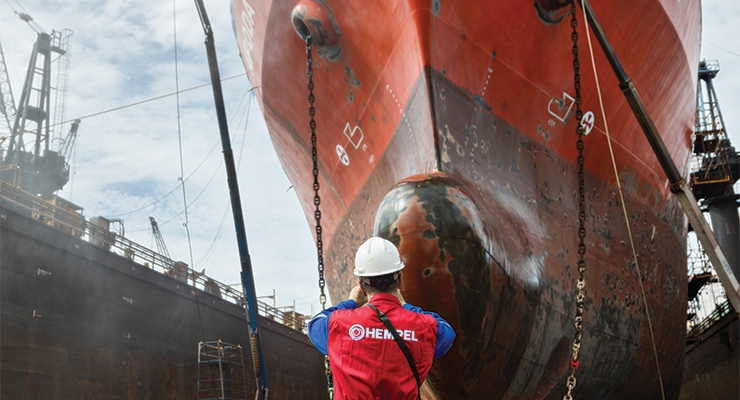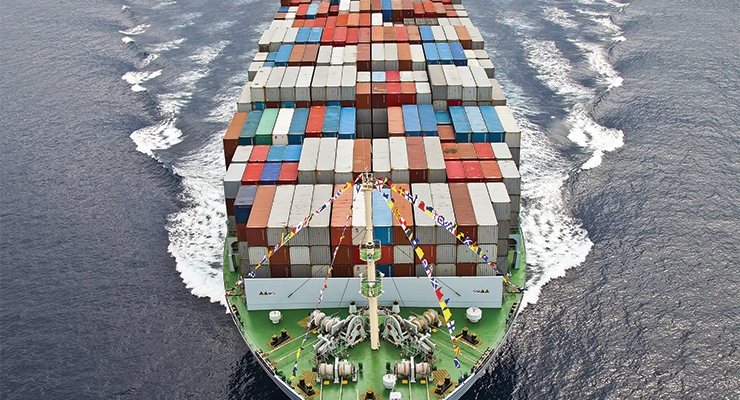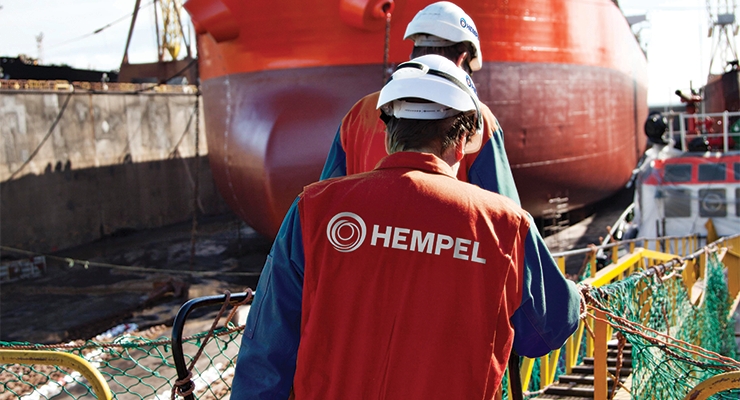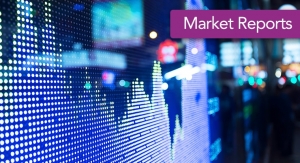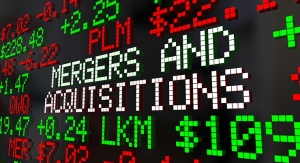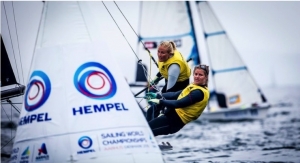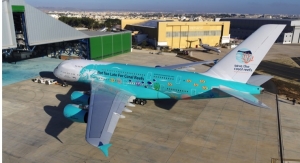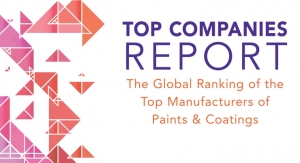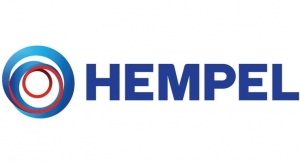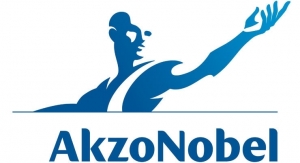Anthony Locicero, Associate Editor08.10.18
The marine coatings market is projected to grow from $3.31 billion in 2017 to $3.93 billion by 2022 – at a CAGR of 3.5 percent – according to research from MarketsandMarkets.
ReportBuyer projects an even larger growth – $5.29 billion by 2022, but also at a CAGR of 3.5 percent from 2017 to 2022. The same research forecasted the 2017 market at $4.45 billion.
While overall growth is predicted, “the marine coatings market has been and is weak due to low new build ordering from owners in 2016 and 2017,” Hempel’s group VP, head of Marine Business Christian Ottosen said, adding that 2016 was the lowest ordering year in three decades.
“However, repair and maintenance are partly – but not fully – compensating for a decrease in new building,” he added.
“Globally, the marine market continues to be down compared to previous years, but we have seen some bright spots,” said John Mangano, key account manager, Coastal & Navy Marine & Protective Coatings for AkzoNobel.
That bright spot is with the military, according to Mangano.
“Federal funding is coming through, which is driving repairs to existing ships as well as new U.S. Navy ships getting the green light to being built,” he said.
In addition to the military, “there are numerous regulations that are having an impact on the marine coatings market and its growth,” said Tom Molenda, PPG's director of Global Marine Coatings.
“The IMO ballast water management regulation, NOX, SOX, EEDI requirements all will impact the dynamics and the growth rates of new construction and therefore the coatings demand in the foreseeable future,” Molenda noted.
“Recovery of new build ordering will obviously, with the low level at present, contribute significantly to a growing need for marine coatings,” Ottosen said. “For repair and maintenance, the market is growing in itself by the growth in fleet during the past ten years or more, as vessels are now coming into first or second dry dock.
“Furthermore, we see a significant growth and demand for increasingly more energy efficient hull coating solutions, which provide trade flexibility and are supported by fuel monitoring services that ensure the most optimum operation and lowest bunker costs in a five-year drydock interval,” Ottosen added.
Growth Expected in Emerging Markets
Market growth is expected to be fueled by an increasing demand from the shipbuilding industry in emerging economies in places such as China, India and Brazil, per MarketsandMarkets.
Various countries in the Asia-Pacific region have expanded their ship manufacturing base, which, in turn, has led to the growth of the Asia-Pacific marine coatings market, the research further stated.
Increasing shipbuilding activities in emerging economies are driving the growth of the marine coatings market across the globe, according to ReportBuyer’s research.
The Asia-Pacific marine coatings market is projected to grow at the highest CAGR during the forecast period, in terms of value, according to MarketsandMarkets.
“Asia historically has had large demand due to large new-build contracts,” Mangano said.
“The majority of demand is derived from the Asia-Pacific region based upon the shipyards in the region and also a growing owner base in the Asian countries,” said Molenda, who noted that Europe also remains a significant owner region for shipping.
Per Ottosen, the biggest area of growth for new build is Asia – specifically China, Korea and Japan. For repairs, “it’s linked to owners’ location, and Europe is still the largest ship-owning area,” he said.
As for dry dock location, China, Singapore and Dubai “are the areas with the most supplies,” Ottosen noted.
Restrictions and Regulations
EU Biocidal Products Regulation (BPR) and REACH (Registration, Evaluation, Authorization and Restriction of Chemicals) continue to have a significant impact on the industry.
“The EU Biocidal Products Regulation are the most stringent laws affecting antifouling products to date,” said Gareth Prowse, Hempel’s regulatory affairs manager, Group HSE & Risk, Group HSE & Risk. “The industry has just entered the product registration phase for copper-based antifoulings following the recent deadline for submission at the start of this year. This will begin the re-approval process for those products according to the new risk assessment rules.”
“While [being] a change and a disruption, these regulations also provide an opportunity for us and other coating manufacturers,” Molenda said. "At PPG, we continuously focus on being environmentally conscious and ahead of such regulations.”
Molenda added that PPG expects to be “well ahead” of soon-to-be enacted regulations in emerging markets such as Korea and China.
“We are following closely the developments on the upcoming KBPR,” he said.
“We don’t expect to face the loss of marine products from the market as a result of the new rules – the majority of the issues identified with existing biocides have already been addressed as part of the active substance approval process, a process which led to the phasing out of cybutryne,” Prowse added.
According to Mangano, AkzoNobel sees two current trends: “The demand for coatings that increase fuel efficiency, and the desire by ship owners and shipbuilders to fight fouling and invasive species that can impact local ecosystems and efficient operations of shipping companies.
“In regards to invasive species, we have seen an uptick in customers who want better-performing antifoulings, so they can trade globally uninhibited and are able to meet various countries’ regulations,” he added.
Prowse noted that Korea has recently enacted legislation that is equivalent to both BPR and REACH.
“We don’t expect specific rules affecting antifoulings to come into force for a number of years, but we aren’t complacent and continue to monitor and prepare for any possible impact that may arise,” Prowse continued. “China is a key market for Hempel and we are following developments there closely to ensure our products meet any new requirements that may come into force.
“What impact these new rules have on the global antifouling market remains to be seen, but in general we see an increase in regulation globally, as well as attempts to harmonize restrictions,” Prowse said.
“Regulators are accounting for decisions made outside of their own region as part of their assessment processes – as was the case in New Zealand. More recently, the European countries party to the IMO Antifouling Systems (AFS) Convention proposed that cybutryne should be added to Annex 1 of the convention resulting in global controls on the use of cybutryne,” he explained.
“The assessment to be carried out by the IMO will be of great interest to the industry as it is the first time since Organotin compounds (i.e. TBT) were listed in the annex. How the IMO assessment accommodates the restriction decision to restrict the substance by the European Union alongside any specific assessment criteria of non-EU Parties will no doubt be a topic for debate going forward,” Prowse concluded.
Increase in Raw Material Prices
In addition to increasing regulations, the industry has faced challenges with raw materials prices and supply issues.
In February, Hempel increased prices.
“Raw material pricing has escalated significantly and, while we have done everything possible to minimize the impact to our customers, the need to pass on price increases is an unavoidable reality,” Hildreth said.
“Over the past two years, the cost of many raw materials used in the manufacturing of coatings has continued to rise,” said Michael Hansen, executive vice president and chief commercial officer at Hempel.
“During Q4 2017 alone, for example, the cost of epoxy increased by 20 percent in Europe and North America and as much as 58 percent in the Middle East and South & East Asia, per ICIS Pricing and Technon Orbichem," he added. "In the same period, the price of zinc increased nearly 15 percent globally, reaching a 10-year high at the start of 2018, according to London Metal Exchange.
“There are regional differences, but overall global prices are clearly rising,” Hansen continued. “We did our best during Q1 2018 to absorb these price increases and limit the effect on our customers. However, we had no other option than to increase the prices of some of our products in our protective, marine, container, yacht and decorative segments.”
“As a consequence, AkzoNobel is implementing a range of measures to mitigate these market challenges, including increased selling prices and cost discipline,” Mangano said. “While conditions are changing, our team continues to work tirelessly to meet and exceed our customers’ needs.”
New Trends and Technology
So where do the experts see the market heading?
The anti-corrosion coatings segment is expected to lead the marine coatings market between 2017 and 2022, in terms of value, per ReportBuyer’s research.
The trends “vary greatly” between market sectors, according to Mangano.
“Customers are very interested in lower VOC, especially as new regulations continue to emerge for that,” he said. “Furthermore, our customers ask a lot for universal primers and high-performance anti-fouling coatings.
“Overall, the technology is headed toward a more state-of-the-art anti-fouling coating,” he continued. “For example, our teams are working on UV-LED technology that essentially uses light to organically minimize fouling attaching to the ship. Also, light-weight deck coatings are popular to reduce a vessel’s weight.
“From a deep-sea perspective, a big concern among our customers is validating – i.e., they look to us for having the best solutions to make the best decisions and being able to validate performance. That’s why we offer our Intertrac suite of services, which uses Intertrac vision and Intertrac Perform to help with exactly that,” Mangano concluded.
“The trends are focused around improving vessel performance and operational efficiency,” Molenda said. “Fouling control products are a clear focus and solutions that not only provide superior performance but also help the owners to meet the industry’s environmental targets such as our SigmaGlide foul release solution) have a bright future.”
Added Ottosen: “Energy efficiency, carbon dioxide reductions and supplementary services documenting efficiency gains in operations.”
The fouling on a ship’s hull creates friction as a vessel moves through the water. This friction increases the power needed by the ship to maintain a given speed, which in turn leads to higher fuel consumption and more emissions.
Any ship will start to accumulate fouling on its hull as soon as it hits the water. An initial single cell, light slime micro fouling could increase the fuel bill by seven to nine percent. Over time, with growth and the arrival of larger organisms, plants, and animals, the resulting drag could increase fuel consumption by as much as 30 percent. In today’s challenging markets this is an increasing cost that few ship owners or operators can afford and so unsurprisingly, the global shipping industry is increasingly focused on fuel efficiency.
ISO (International Organization for Standardization) 19030, which was published last year, describes how to measure the changes in ship specific hull and propeller performance, and defines a set of performance indicators for hull and propeller maintenance, and repair activities. However, at the moment only about 15 percent of the world’s fleet can comply with ISO 19030.
Hempel’s Systems for Hull and Propeller Efficiency (SHAPE) is based on the ISO 19030 framework and uses Hempel’s world-class coatings knowledge from more than 100 years of experience. Combined with expert performance analysis of the vessel’s hull and propeller efficiency conducted by Hempel’s team of chemists, physicists, and hydrodynamicists, SHAPE can deliver documented fuel savings, an improved return on investment and a program of continuous improvement.
Designed to follow the principles of ISO 19030, Hempel’s SHAPE monitors a vessel’s long-term trends using in service key performance indicators (KPI). This provides detailed data allowing the ship owner or operator to make fact-based operational decisions.
This level of detailed data interpretation allows Hempel’s SHAPE to offer a more flexible solution. This provides transparent performance monitoring and the industry’s most sophisticated efficiency analysis – now available to all ship owners and operators.
The high-quality data gathering, expert analysis, decisive advice and world-class hull coatings, all combine to become the vessel’s leading source of efficiency knowledge and solutions – whatever the age, size and operating patterns of the ship.
Hempel’s SHAPE is much more than just performance monitoring, it offers fuel efficiency intelligence to help your vessel to be more efficient and competitive in today’s ever-changing marine world.
ReportBuyer projects an even larger growth – $5.29 billion by 2022, but also at a CAGR of 3.5 percent from 2017 to 2022. The same research forecasted the 2017 market at $4.45 billion.
While overall growth is predicted, “the marine coatings market has been and is weak due to low new build ordering from owners in 2016 and 2017,” Hempel’s group VP, head of Marine Business Christian Ottosen said, adding that 2016 was the lowest ordering year in three decades.
“However, repair and maintenance are partly – but not fully – compensating for a decrease in new building,” he added.
“Globally, the marine market continues to be down compared to previous years, but we have seen some bright spots,” said John Mangano, key account manager, Coastal & Navy Marine & Protective Coatings for AkzoNobel.
That bright spot is with the military, according to Mangano.
“Federal funding is coming through, which is driving repairs to existing ships as well as new U.S. Navy ships getting the green light to being built,” he said.
In addition to the military, “there are numerous regulations that are having an impact on the marine coatings market and its growth,” said Tom Molenda, PPG's director of Global Marine Coatings.
“The IMO ballast water management regulation, NOX, SOX, EEDI requirements all will impact the dynamics and the growth rates of new construction and therefore the coatings demand in the foreseeable future,” Molenda noted.
“Recovery of new build ordering will obviously, with the low level at present, contribute significantly to a growing need for marine coatings,” Ottosen said. “For repair and maintenance, the market is growing in itself by the growth in fleet during the past ten years or more, as vessels are now coming into first or second dry dock.
“Furthermore, we see a significant growth and demand for increasingly more energy efficient hull coating solutions, which provide trade flexibility and are supported by fuel monitoring services that ensure the most optimum operation and lowest bunker costs in a five-year drydock interval,” Ottosen added.
Growth Expected in Emerging Markets
Market growth is expected to be fueled by an increasing demand from the shipbuilding industry in emerging economies in places such as China, India and Brazil, per MarketsandMarkets.
Various countries in the Asia-Pacific region have expanded their ship manufacturing base, which, in turn, has led to the growth of the Asia-Pacific marine coatings market, the research further stated.
Increasing shipbuilding activities in emerging economies are driving the growth of the marine coatings market across the globe, according to ReportBuyer’s research.
The Asia-Pacific marine coatings market is projected to grow at the highest CAGR during the forecast period, in terms of value, according to MarketsandMarkets.
“Asia historically has had large demand due to large new-build contracts,” Mangano said.
“The majority of demand is derived from the Asia-Pacific region based upon the shipyards in the region and also a growing owner base in the Asian countries,” said Molenda, who noted that Europe also remains a significant owner region for shipping.
Per Ottosen, the biggest area of growth for new build is Asia – specifically China, Korea and Japan. For repairs, “it’s linked to owners’ location, and Europe is still the largest ship-owning area,” he said.
As for dry dock location, China, Singapore and Dubai “are the areas with the most supplies,” Ottosen noted.
Restrictions and Regulations
EU Biocidal Products Regulation (BPR) and REACH (Registration, Evaluation, Authorization and Restriction of Chemicals) continue to have a significant impact on the industry.
“The EU Biocidal Products Regulation are the most stringent laws affecting antifouling products to date,” said Gareth Prowse, Hempel’s regulatory affairs manager, Group HSE & Risk, Group HSE & Risk. “The industry has just entered the product registration phase for copper-based antifoulings following the recent deadline for submission at the start of this year. This will begin the re-approval process for those products according to the new risk assessment rules.”
“While [being] a change and a disruption, these regulations also provide an opportunity for us and other coating manufacturers,” Molenda said. "At PPG, we continuously focus on being environmentally conscious and ahead of such regulations.”
Molenda added that PPG expects to be “well ahead” of soon-to-be enacted regulations in emerging markets such as Korea and China.
“We are following closely the developments on the upcoming KBPR,” he said.
“We don’t expect to face the loss of marine products from the market as a result of the new rules – the majority of the issues identified with existing biocides have already been addressed as part of the active substance approval process, a process which led to the phasing out of cybutryne,” Prowse added.
According to Mangano, AkzoNobel sees two current trends: “The demand for coatings that increase fuel efficiency, and the desire by ship owners and shipbuilders to fight fouling and invasive species that can impact local ecosystems and efficient operations of shipping companies.
“In regards to invasive species, we have seen an uptick in customers who want better-performing antifoulings, so they can trade globally uninhibited and are able to meet various countries’ regulations,” he added.
Prowse noted that Korea has recently enacted legislation that is equivalent to both BPR and REACH.
“We don’t expect specific rules affecting antifoulings to come into force for a number of years, but we aren’t complacent and continue to monitor and prepare for any possible impact that may arise,” Prowse continued. “China is a key market for Hempel and we are following developments there closely to ensure our products meet any new requirements that may come into force.
“What impact these new rules have on the global antifouling market remains to be seen, but in general we see an increase in regulation globally, as well as attempts to harmonize restrictions,” Prowse said.
“Regulators are accounting for decisions made outside of their own region as part of their assessment processes – as was the case in New Zealand. More recently, the European countries party to the IMO Antifouling Systems (AFS) Convention proposed that cybutryne should be added to Annex 1 of the convention resulting in global controls on the use of cybutryne,” he explained.
“The assessment to be carried out by the IMO will be of great interest to the industry as it is the first time since Organotin compounds (i.e. TBT) were listed in the annex. How the IMO assessment accommodates the restriction decision to restrict the substance by the European Union alongside any specific assessment criteria of non-EU Parties will no doubt be a topic for debate going forward,” Prowse concluded.
Increase in Raw Material Prices
In addition to increasing regulations, the industry has faced challenges with raw materials prices and supply issues.
In February, Hempel increased prices.
“Raw material pricing has escalated significantly and, while we have done everything possible to minimize the impact to our customers, the need to pass on price increases is an unavoidable reality,” Hildreth said.
“Over the past two years, the cost of many raw materials used in the manufacturing of coatings has continued to rise,” said Michael Hansen, executive vice president and chief commercial officer at Hempel.
“During Q4 2017 alone, for example, the cost of epoxy increased by 20 percent in Europe and North America and as much as 58 percent in the Middle East and South & East Asia, per ICIS Pricing and Technon Orbichem," he added. "In the same period, the price of zinc increased nearly 15 percent globally, reaching a 10-year high at the start of 2018, according to London Metal Exchange.
“There are regional differences, but overall global prices are clearly rising,” Hansen continued. “We did our best during Q1 2018 to absorb these price increases and limit the effect on our customers. However, we had no other option than to increase the prices of some of our products in our protective, marine, container, yacht and decorative segments.”
“As a consequence, AkzoNobel is implementing a range of measures to mitigate these market challenges, including increased selling prices and cost discipline,” Mangano said. “While conditions are changing, our team continues to work tirelessly to meet and exceed our customers’ needs.”
New Trends and Technology
So where do the experts see the market heading?
The anti-corrosion coatings segment is expected to lead the marine coatings market between 2017 and 2022, in terms of value, per ReportBuyer’s research.
The trends “vary greatly” between market sectors, according to Mangano.
“Customers are very interested in lower VOC, especially as new regulations continue to emerge for that,” he said. “Furthermore, our customers ask a lot for universal primers and high-performance anti-fouling coatings.
“Overall, the technology is headed toward a more state-of-the-art anti-fouling coating,” he continued. “For example, our teams are working on UV-LED technology that essentially uses light to organically minimize fouling attaching to the ship. Also, light-weight deck coatings are popular to reduce a vessel’s weight.
“From a deep-sea perspective, a big concern among our customers is validating – i.e., they look to us for having the best solutions to make the best decisions and being able to validate performance. That’s why we offer our Intertrac suite of services, which uses Intertrac vision and Intertrac Perform to help with exactly that,” Mangano concluded.
“The trends are focused around improving vessel performance and operational efficiency,” Molenda said. “Fouling control products are a clear focus and solutions that not only provide superior performance but also help the owners to meet the industry’s environmental targets such as our SigmaGlide foul release solution) have a bright future.”
Added Ottosen: “Energy efficiency, carbon dioxide reductions and supplementary services documenting efficiency gains in operations.”
The fouling on a ship’s hull creates friction as a vessel moves through the water. This friction increases the power needed by the ship to maintain a given speed, which in turn leads to higher fuel consumption and more emissions.
Any ship will start to accumulate fouling on its hull as soon as it hits the water. An initial single cell, light slime micro fouling could increase the fuel bill by seven to nine percent. Over time, with growth and the arrival of larger organisms, plants, and animals, the resulting drag could increase fuel consumption by as much as 30 percent. In today’s challenging markets this is an increasing cost that few ship owners or operators can afford and so unsurprisingly, the global shipping industry is increasingly focused on fuel efficiency.
ISO (International Organization for Standardization) 19030, which was published last year, describes how to measure the changes in ship specific hull and propeller performance, and defines a set of performance indicators for hull and propeller maintenance, and repair activities. However, at the moment only about 15 percent of the world’s fleet can comply with ISO 19030.
Hempel’s Systems for Hull and Propeller Efficiency (SHAPE) is based on the ISO 19030 framework and uses Hempel’s world-class coatings knowledge from more than 100 years of experience. Combined with expert performance analysis of the vessel’s hull and propeller efficiency conducted by Hempel’s team of chemists, physicists, and hydrodynamicists, SHAPE can deliver documented fuel savings, an improved return on investment and a program of continuous improvement.
Designed to follow the principles of ISO 19030, Hempel’s SHAPE monitors a vessel’s long-term trends using in service key performance indicators (KPI). This provides detailed data allowing the ship owner or operator to make fact-based operational decisions.
This level of detailed data interpretation allows Hempel’s SHAPE to offer a more flexible solution. This provides transparent performance monitoring and the industry’s most sophisticated efficiency analysis – now available to all ship owners and operators.
The high-quality data gathering, expert analysis, decisive advice and world-class hull coatings, all combine to become the vessel’s leading source of efficiency knowledge and solutions – whatever the age, size and operating patterns of the ship.
Hempel’s SHAPE is much more than just performance monitoring, it offers fuel efficiency intelligence to help your vessel to be more efficient and competitive in today’s ever-changing marine world.


